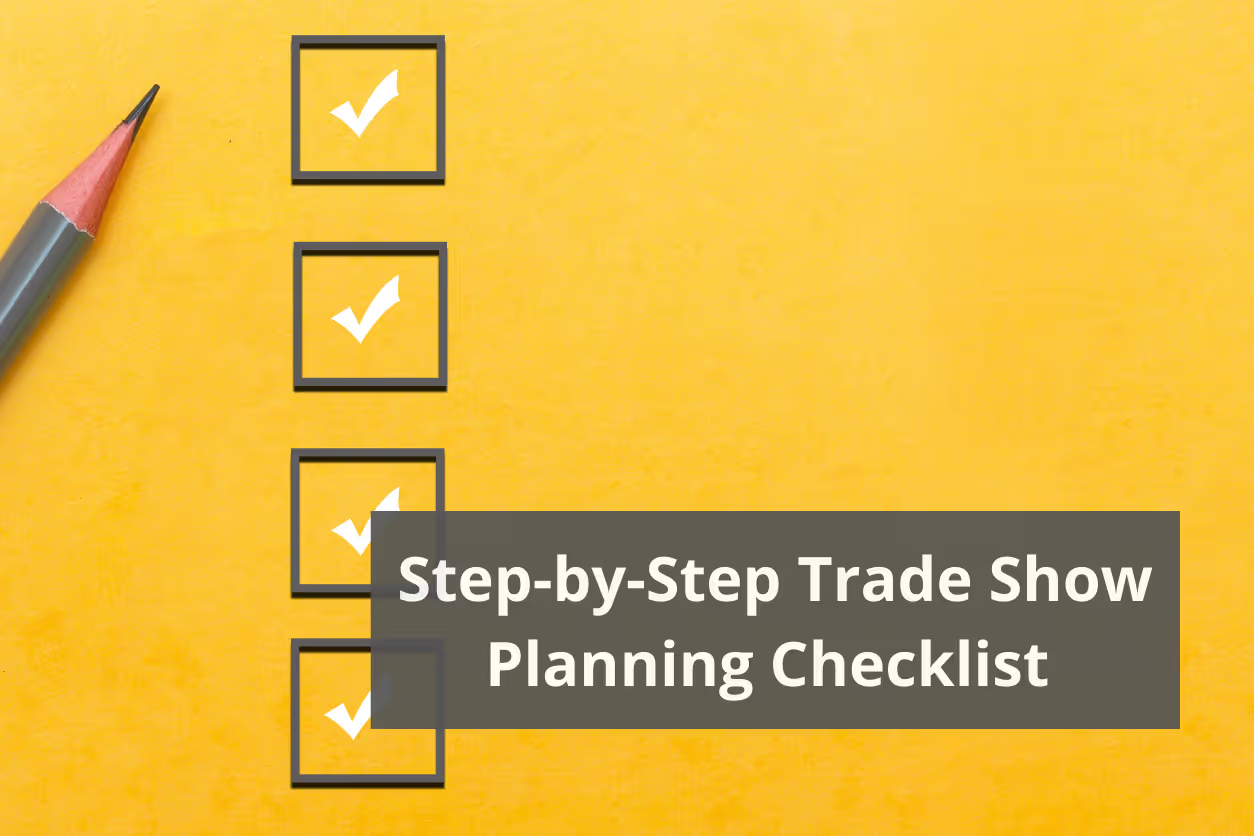Trade shows are golden opportunities to showcase your brand, network with industry peers, and gain valuable leads. But without planning or using an event checklist, they can quickly become overwhelming.
To ensure a seamless and successful experience, follow this trade show checklist, packed with best practices and tips for both seasoned show goers and first-time exhibitors.
How Do You Organize a Trade Show Checklist?
The key is to divide your checklist into phases, aligning with the natural timeline of trade show preparation:
Pre-Trade Show Planning (4-6 months out):
- Define Your Objectives: What is the main goal of going to the show? Are you hoping to increase your brand awareness? Are you focused on lead generation or product sales? Did you just launch a new service you want to highlight?
Setting clear goals can't be overstated and will guide the rest of your decisions for the event. For example, a booth primarily focusing on brand awareness will be laid out differently and with a different design aesthetic than a display booth geared toward lead generation. Defining what success looks like for your event is the very first thing you need to do.
- Set Your Budget: Allocate funds for booth space, design, marketing materials, travel, and any additional expenses. Be realistic and have a contingency plan for unexpected costs. (here is a simple tool to help you get started)
- Research Trade Shows: Use a tool like the TSNN trade show calendar to help locate shows that best align with your industry, target audience, and objectives. Consider factors like industry focus, attendee demographics, show reputation, and overall expected return on investment.
- Register Early: Secure your booth space as early as possible to get the best location and take advantage of early bird discounts. This helps ensure that your brand lands in the “hot spot” zones of the event that add additional value to your purchase.
Booth Design and Logistics (3-4 months out):
- Design Your Booth: Create an eye-catching and functional booth design that reflects your brand and showcases your products/services. We recommend working with a design professional to create a premium design. You want to avoid being too busy but you also want to avoid being boring. Many trade show display providers offer design services for their products. Additionally, many marketing agencies offer large format trade show specific design as well.

- Order Marketing Materials: Brochures, flyers, business cards, promotional items – make sure you have ample supplies to distribute. Don’t wait to order your marketing materials. The smallest delays in production or shipping can have huge impacts on last minute orders.
- Arrange Shipping: If you have a larger booth or equipment, coordinate shipping to the venue well in advance. Be sure to use your show provided shipping label, generally located near the end of your exhibitor pamphlet. These shipping labels define dates, locations, and specific times packages can arrive. They also help the show know what booth the packages need to go to, avoiding lost packages at the show warehouse.
- Book Travel and Accommodations: Secure flights, hotels, and any necessary transportation for your team. Generally speaking, the earlier you book, the better rates you can get.
Pre-Show Marketing (1-3 months out):
- Promote Your Presence: Utilize social media, email marketing, and your website to announce your participation and generate excitement. Offer incentives and share your booth number to make sure people know where you are.
- Schedule Meetings: Connect with potential clients, partners, or media contacts to set up meetings at the show. Client dinners and after hour events can be a big part of your trade show success. Be sure to maximize your time at and after the show each day.

On-Site Execution:
- Set Up Your Booth: Many exhibitors assemble and disassemble their own booth which means you will need to arrive early for setup days and schedule enough time after the event to take your booth down. If you have a smaller booth like a 10x10 or 10x20, there are plenty of options to use your shipping case as a counter and keep it hidden in your booth. However, if you have to give your empty cases to show services, it can take hours after the event to get them back.
- Engage with Attendees: Be approachable, enthusiastic, and knowledgeable about your offerings. Prepare a list of talking points and questions you expect to be asked by attendees. Have a lead collection strategy and be persistent in collecting information.
- Network: Attend industry events, seminars, and social gatherings to make valuable connections.
- Evaluate Your Performance: Take notes on what worked well and what could be improved for future shows.
Post-Show Follow-Up: (1-7 Days)
- Lead Nurturing: Follow up with leads through email campaigns, phone calls, or personalized offers. We recommend waiting a few days to give everyone time to get caught up at work.
- Analyze Results: Measure your ROI and assess the overall success of the show. Use this data to refine your strategy for future events.
What is Considered Best Practice for Trade Show Planning?
- Start Early: The earlier you start planning, the less stressful and more successful your trade show will be.
- Set SMART Goals: Specific, Measurable, Achievable, Relevant, and Time-Bound objectives will keep you focused and motivated.
- Invest in Your Booth: A well-designed and engaging booth is essential for attracting attention and generating leads.
- Promote Your Presence: Don't rely solely on the trade show organizers to promote your attendance. Utilize your own marketing channels to spread the word.
- Train Your Staff: Ensure your booth staff are well-informed, enthusiastic, and prepared to engage with attendees.
- Follow Up: The real work begins after the show. Nurture your leads and build lasting relationships.
How Long Does it Take to Plan for a Trade Show?
The ideal planning timeline depends on the booth size and complexity. For most 10x10, 10x20, and 20x20 booths, 4-6 months is generally a comfortable timeline. However, with efficient planning and a well-organized trade show exhibitor checklist, you can successfully execute a show in a much shorter time frame.
Additional Tips for a Successful Trade Show:
- Create a Vendor Booth Checklist: If you're working with vendors, provide them with a clear checklist of deliverables and deadlines.
- Prepare for the Unexpected: Have a backup plan for any unforeseen circumstances, such as shipping delays or technical issues.
- Track Your Expenses: Keep a detailed record of all expenses to accurately measure your ROI.
By following this step-by-step checklist and incorporating these best practices, you'll be well on your way to a seamless and successful trade show experience.






.jpg)

.png)

.avif)





